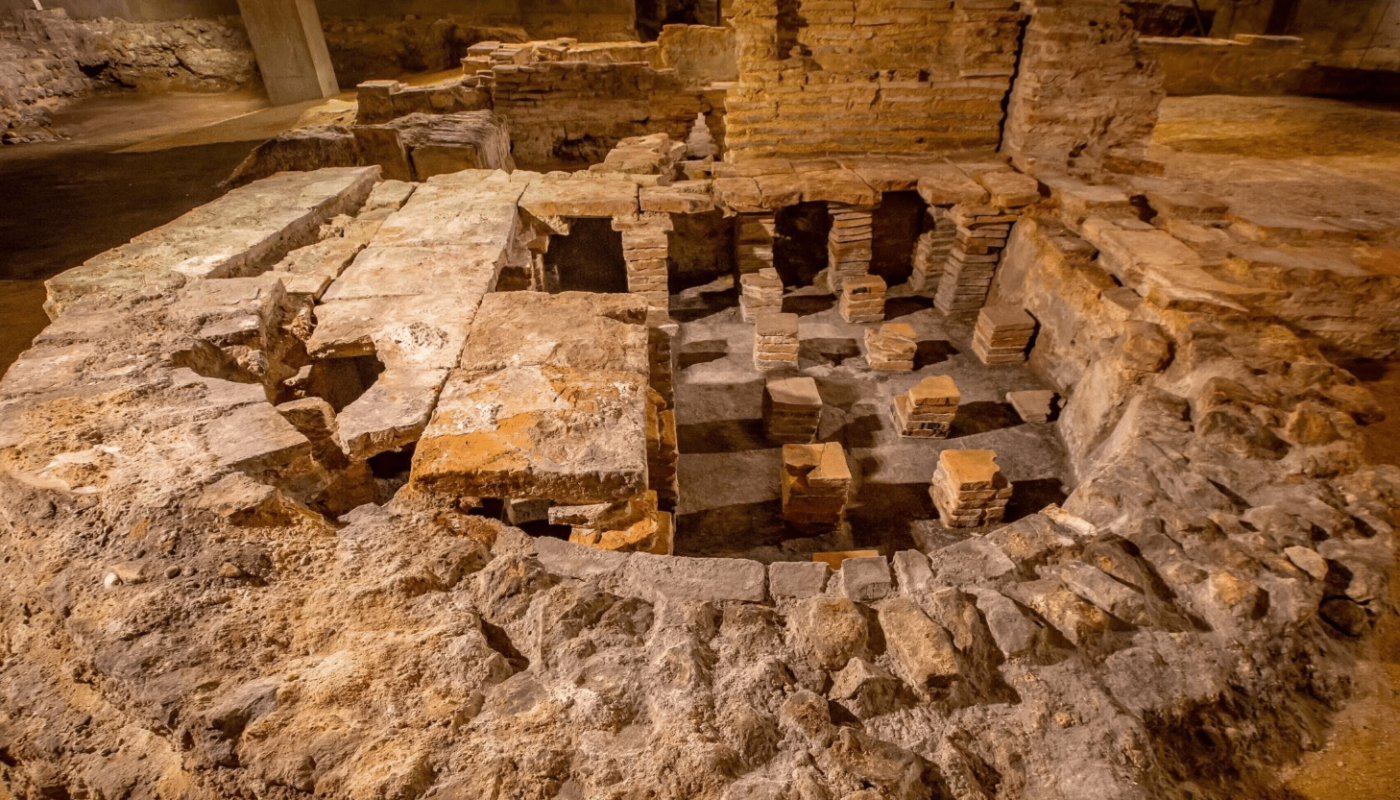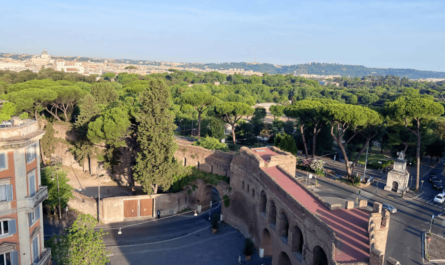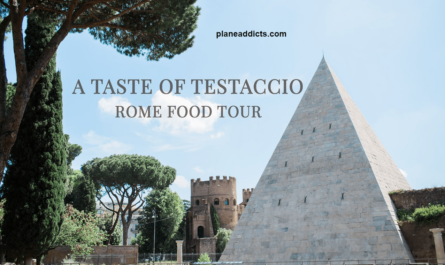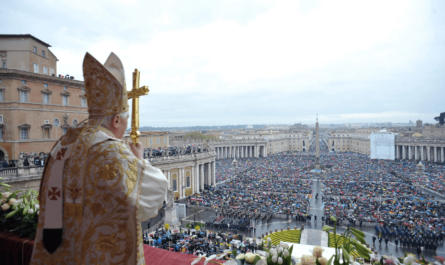27 Remarkable Roman Ruins: Rome is undeniably a top destination for archaeology enthusiasts. From the iconic Colosseum to the scattered ruins of ancient aqueducts throughout the city, Rome truly lives up to its reputation as an open-air museum. This curated list of the most captivating ancient Roman ruins will guide you through the remarkable sites that helped shape the sophisticated Roman civilization.
While every site has its unique charm, prioritizing can be crucial if you’re short on time. Here are our recommendations for some of the most extraordinary archaeological locations in Rome that should be on your must-visit list. Let’s explore!
Roman Ruins : Exceptional Archaeological Sites in Rome
Colosseum
You can’t start an exploration of Rome’s ancient sites without mentioning the Colosseum. This iconic amphitheater, constructed in the 1st century, is the most popular landmark in Rome and a must-see for any visitor. It was the venue for gladiatorial combats and wild beast fights, serving both emperors and the general public.
Various tours are available, ranging from general access to exclusive tours that include restricted areas. Choose based on your interests and budget.
Roman Forum and Palatine Hill
Adjacent to the Colosseum, the Roman Forum and Palatine Hill are central to Rome’s ancient history. This area, once bustling with temples, shops, and altars, was the heart of ancient Rome. Visitors can explore the site where Julius Caesar was cremated and view the remains of his altar, and wander through the ruins on the Palatine Hill, believed to be Rome’s first settlement.
These sites are among the largest ancient remnants in Rome. It’s advisable to book tickets online, especially during peak seasons like summer or December.
Baths of Caracalla
The Baths of Caracalla offer a glimpse into the Romans’ love for relaxation and socializing. This extensive complex, featuring mosaics, statues, arches, and vaults, reveals the grandeur of ancient Roman bathhouses. A significant feature is Rome’s largest Mithra temple, located underground.
The site is well-preserved, allowing visitors to explore various rooms and understand the ancient bathhouse’s layout and operations. Don’t miss the underground areas, which show where slaves managed the furnaces to keep the baths warm.
Mausoleum of Augustus
Reopened in March 2021 after 14 years of renovation, the Mausoleum of Augustus is the grand tomb of Rome’s first emperor. This enormous circular structure was inspired by Etruscan funerary monuments and served as the burial site for several prominent figures of the Julia-Claudia dynasty, including Augustus himself.
Throughout its history, the mausoleum has been adapted for various uses, including as a fortress and an amphitheater. It’s fascinating to see how the structure has evolved over time.
Teatro di Marcello
The Teatro di Marcello, named in honor of Augustus’ deceased nephew, was begun under Julius Caesar and completed by Augustus. Located in the Campo Marzio area, the theater once hosted public performances and legislative gatherings. It was later repurposed during the Christian era, eventually becoming a fortress.
Today, it’s visible from the outside, and a visit can be combined with trips to nearby sites such as the Capitoline Museums or the Portico d’Ottavia in the Jewish Ghetto.
Portico di Ottavia
Adjacent to the Theater of Marcellus, the Portico di Ottavia offers insight into Rome’s ancient grandeur. Originally built in 146 BC by Quintus Caecilius Metellus Macedonicus, it featured temples and libraries. Augustus renovated it between 27 and 23 BC, and Emperor Septimius Severus made further modifications in 203 AD.
The Portico di Ottavia, now nestled within the Jewish Quarter, is easily accessible. It’s open to visitors and provides a chance to explore Rome’s ancient architectural and historical layers.
Vicus Caprarius
Hidden near the Trevi Fountain, Vicus Caprarius is a lesser-known site with fascinating historical significance. Known as the “city of water,” it is built on the Aqua Virgo cistern, which supplies water to famous Roman fountains. Besides the aqueduct remains, the site offers glimpses of the ancient neighborhood that once thrived here.
Aqua Virgo Ancient Ruins
The remnants of the Aqua Virgo aqueduct can be seen at various locations across Rome. Notable spots include near the Trevi Fountain and La Rinascente shopping mall. The ruins offer a glimpse into Rome’s advanced water management system. The La Rinascente site also features a multimedia installation that provides additional historical context.
San Clemente Basilica
Located behind the Colosseum, San Clemente Basilica presents a rich historical experience. The medieval basilica sits atop a 4th-century early Christian church and Roman neighborhood ruins. Visitors can explore the remains of a Mithra temple, Roman mint, and ancient streets.
Santa Cecilia in Trastevere Basilica
A highlight of Trastevere, Santa Cecilia Basilica’s underground area reveals an ancient domus, including baths and a shop entrance. The crypt, adorned with arches and vaults, houses the saint’s tomb. The area is close to excellent dining options, making it easy to enjoy a traditional Roman meal afterward.
Vatican Necropolis
Beneath St. Peter’s Basilica lies the ancient Roman necropolis, offering a unique glimpse into early Christian and Roman history. This sprawling site includes the Circus of Nero, where Christians were persecuted and Peter was martyred. A visit here provides valuable historical insights.
Hadrian Mausoleum
Also known as Castel Sant’Angelo, this mausoleum was initially built as a tomb for Emperor Hadrian. Over time, it became a papal residence and prison. The mausoleum offers a rich historical experience and stunning views of St. Peter’s Basilica.
Parco degli Acquedotti
For those interested in Roman engineering, Parco degli Acquedotti showcases six of Rome’s ancient aqueducts. Located along the Appian Way, this park provides a relaxing environment for exploring the impressive engineering feats of ancient Rome.
Sant’Agnese Fuori le Mura Complex
This complex on Via Nomentana includes significant early-Christian sites, such as large catacombs, a 4th-century basilica, and the Mausoleum of Costanza. The site offers a deep dive into Roman art and history.
St. Paul Outside the Walls Undergrounds
Beneath the Basilica of San Paolo Fuori le Mura, you can explore an extensive ancient Roman site. The area includes remnants from various periods, including early ecclesiastical buildings and residential structures.
Stadium of Domitian
Piazza Navona’s oval shape reveals its origins as the Stadium of Domitian. Built to promote Greek sports, the stadium’s remains include detailed carvings and ornamental statues. Visitors can see representations of the stadium’s historical layout.
Rome’s Catacombs
Rome’s catacombs, spread throughout the city, offer a fascinating glimpse into early Christianity. Sites like Priscilla Catacombs and San Callisto provide insights into Christian burial practices and transitions from paganism.
Rome’s Mithra Temples
Several Mithra temples can be found in Rome, often located underground and accessible by prior arrangement. Notable sites include those beneath San Clemente Basilica, the Baths of Caracalla, and Circus Maximus.
Pyramid of Caestius
Located in the Testaccio neighborhood, the Pyramid of Caius Cestius stands out due to its Egyptian-inspired design. Though access may be limited, it remains a striking feature of Rome’s architectural diversity.
Trajan’s Markets
Trajan’s Markets offer an immersive experience in Rome’s Imperial Fora. The site includes interactive panels and multimedia presentations that showcase the historical significance of this ancient marketplace.
Domus Aurea
Emperor Nero’s Domus Aurea was an opulent palace complex, built after the 64 AD fire. Covering over 50 hectares, it was the largest and most lavish residential mansion in Rome. Visitors can explore its remains and experience a multimedia presentation.
Circus Maximus
The Circus Maximus, once a grand chariot racing venue, now serves as a park for recreation and public events. The Circo Massimo Experience offers a tour to visualize its historical grandeur.
Domus Romane of Palazzo Valentini
Explore the Domus Romane beneath Palazzo Valentini, where ancient Roman residences are showcased with modern multimedia enhancements.
Diocletian Baths at Museo Nazionale Romano
Discover the remains of the Diocletian Baths, now part of the Museo Nazionale Romano, which offer a glimpse into Rome’s largest ancient bathhouse.
Crypta Balbi
Part of the Museo Nazionale Romano, Crypta Balbi provides insights into urban transformation from ancient to medieval Rome. The site includes a well-preserved 1st-century theater and various layers of Rome’s historical evolution.
Largo Argentina
Largo Argentina houses the remains of four temples dating back to the Republican period, offering a glimpse into early Roman architecture and religious practices.
Insula of the Ara Coeli
The Insula of the Ara Coeli, visible behind the famous Church of Ara Coeli, includes well-preserved apartment buildings from ancient Rome’s urban environment.
Conclusion
Rome’s ancient ruins provide a captivating journey through history, offering insights into the grandeur and daily life of one of history’s most influential civilizations. From the Colosseum’s iconic arena to the hidden gems of underground Rome, exploring these sites promises a deep and enriching experience. Whether you’re an avid history buff or a casual visitor, Rome’s archaeological treasures offer something for everyone. Enjoy your exploration!



